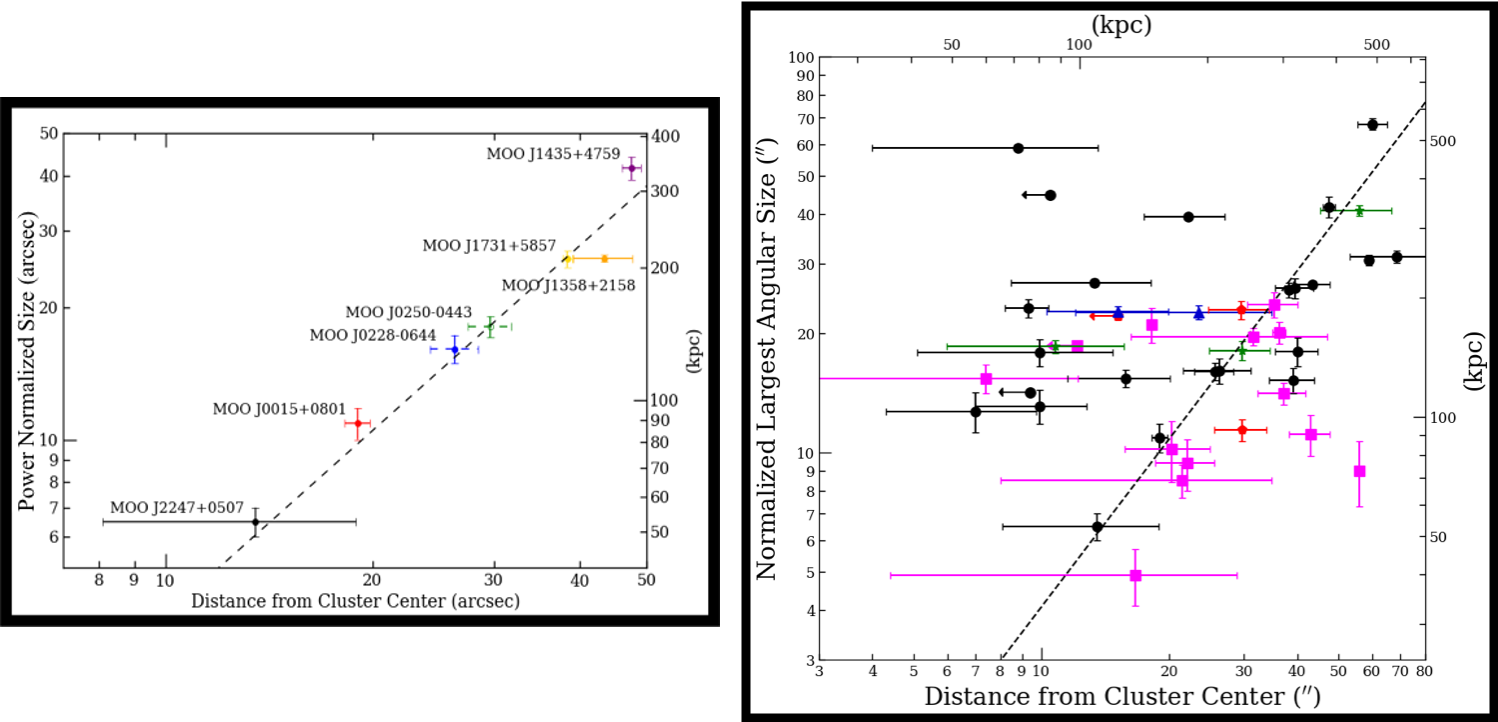Research Question
Does the evironment of a radio galaxy effect its evolution?
Quick Summary
We investigate the role of environmental factors on the radio-loud AGN population by examining correlations between environmental properties and the radio and host galaxy properties of radio galaxies in massive galaxy clusters at z~1. We find that the cluster environment fosters radio activity, especially for massive galaxies near the center, but is not the sole driver of the evolution of the rest of the population.
Publications:
- Pilot Study of 10 Clusters (2019ApJ…871..186M)
- Analysis of Full Sample of 50 Clusters (2020ApJ…888…74M)
Background and Motivation
Active Galactic Nuclei (AGN) and their environments are thought to be linked through AGN feedback which is defined as the interaction and reciprocity between the accretion of matter onto a supermassive black hole (SMBH) and the energetics of the outflowing material and released radiation. On one hand, feedback from AGN jets can have a significant mechanical and thermal impact upon the intracluster medium (ICM) in galaxy clusters by injecting energy into surrounding gas. On the other hand, the ICM can affect the AGN within the cluster by regulating the gas flow to power the AGN.
Recent studies have shown the number of AGN in galaxy clusters and the ratio of AGN to cluster galaxies to increases with increasing redshift. Thus, the high redshift universe is an interesting and promising era to investigate the in situ interaction between the AGN and the ICM within the cluster environment. To this end, our team has been investigating the distribution of AGN and properties of the AGN population associated with z~1 galaxy clusters from the Massive and Distant Clusters of WISE Survey (MaDCoWS: see Gonzalez+19).
Full Summary of Findings
Sample
The sample of ~50 galaxy clusters used in these works are MaDCoWS clusters that were cross-matched with the VLA FIRST survey and identified as having extended radio sources within 1′ of the cluster centers. Using radio (1.4 GHz and 6.0 GHz from the VLA), infrared (3.6μm and 4.5μm from Spitzer), and optical (i-band from PAN-STARRS) data, we determine the radio morphologies and investigate the role of environmental factors on the radio-loud AGN population.
Host Galaxies

Using the infrared counterparts, we find that ~40% of the host galaxies are the candidate brightest cluster galaxy and ~83% are consistent with being one of the top six most massive galaxies in the cluster. We also find that the highest stellar mass hosts are confined to the cluster center and host compact jets.
Radio Properties and Environmental Factors
There is evidence for an increase in the size of the jets with cluster-centric radius, which may be attributed to the decreased ICM pressure confinement with increasing radius.

In the pilot study, we found a strong correlation between the the size of the jets and the distance from the cluster center (see above left plot). In the investigation of the full sample we still see evidence for an increase in the size of the jets with cluster-centric radius (see above right plot), which can be understood as arising due to the decreased ICM pressure confinement with increasing radius. We find that projection effects explain a majority of the scatter of this relation.
Implications
Besides the previously mentioned correlation, there are no other significant correlations between the properties of the radio-AGN (luminosity, morphology, or size) and environmental properties (cluster richness and location within the cluster). The fact that there are more AGN in the cluster environment than the field at this epoch, combined with the lack of strong correlation between galaxy and environmental properties, argues that the cluster environment fosters radio activity but does not solely drive the evolution of these sources at this redshift.
Research Question Answer
Q: Does the evironment of a radio galaxy effect its evolution?
A: The cluster environment fosters radio activity but does not solely drive the evolution of these sources at this redshift.
